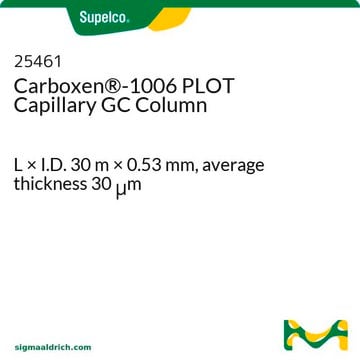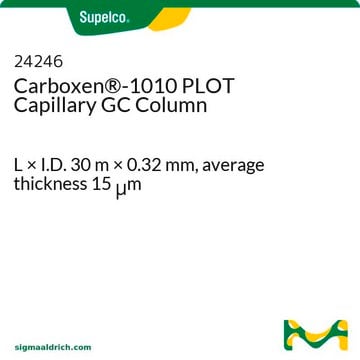25467
Columna capilar para GC Carboxen®-1010 PLOT
L × I.D. 30 m × 0.53 mm, average thickness 30 μm
Sinónimos:
Carboxen® 1010 PLOT Column, 30m x 0.53mm
Iniciar sesiónpara Ver la Fijación de precios por contrato y de la organización
About This Item
Productos recomendados
Materiales
fused silica
Agency
ASTM® D3612-96
descripción
PLOT = Porous Layer Open Tubular
fabricante / nombre comercial
Carboxen®
Parámetros
≤25-250 °C temperature (isothermal or programmed)
grosor promedio
30 μm
df
30 μm
técnicas
gas chromatography (GC): suitable
L × D.I.
30 m × 0.53 mm
grupo activo de la matriz
Carbon molecular sieve phase
aplicaciones
chemicals and industrial polymers
food and beverages
tipo de columna
capillary PLOT
¿Está buscando productos similares? Visita Guía de comparación de productos
Descripción general
Carboxen® Adsorbent is ideally used for solid-phase microextraction (SPME) and does highly efficient extraction of small polar molecules from aqueous solution. Porous-layer open-tubular (PLOT) columns are a powerful tool employed in gas chromatography during analysis of fixed gases, light hydrocarbons and volatile solvents. They are mostly preferred over traditional packed columns.
Application: This column is ideal for the separation of all major components in permanent gas (helium, hydrogen, oxygen, nitrogen, carbon monoxide, methane, and carbon dioxide) and light hydrocarbons (C2-C3) in the same analysis. It is the only column commercially available that is able to separate all major components in permanent gas. This column can also separate oxygen from nitrogen at subambient temperatures.
USP Code: None
Phase:
USP Code: None
Phase:
- Carbon molecular sieve
- Subambient to 250 °C (isothermal or programmed)
Otras notas
We offer a variety of chromatography accessories including analytical syringes
Información legal
ASTM is a registered trademark of American Society for Testing and Materials
Carboxen is a registered trademark of Merck KGaA, Darmstadt, Germany
Aplicación
Referencia del producto
Descripción
Precios
Choose from one of the most recent versions:
¿Ya tiene este producto?
Encuentre la documentación para los productos que ha comprado recientemente en la Biblioteca de documentos.
Los clientes también vieron
Applications of Solid Phase Microextraction
Pawliszyn J.
Applications of Solid Phase Microextraction, 64-65 (1999)
Porous layer open-tubular capillary columns: preparations, applications and future directions.
Zhenghua Ji
Journal of Chromatography A, 842 (1), 115-142 (1999)
B D Page et al.
Journal of chromatography. A, 873(1), 79-94 (2000-04-11)
The headspace solid-phase microextraction (HS-SPME) efficiencies from vegetable oil of the recently available Carboxen-poly(dimethylsiloxane) (PDMS) and divinylbenzene-Carboxen-PDMS fibres were found to be much greater than those of the PDMS fibre for a number of volatile contaminants. Using these Carboxen-based fibres
Dawn M Chapman et al.
Journal of agricultural and food chemistry, 52(17), 5431-5435 (2004-08-19)
A rapid and automated solid phase microextraction (SPME) stable isotope dilution gas chromatography/mass spectrometry (GC-MS) method for 2-methoxy-3-isobutylpyrazine (MIBP) quantification in red wine was developed. Wines with 30% (w/v) NaCl and 2-methoxy-(2)H(3)-3-isobutylpyrazine internal standard were sampled with a 2 cm
Lucia Giordano et al.
Journal of chromatography. A, 1017(1-2), 141-149 (2003-10-31)
A new method was developed for the determination of 2-furfural (2-F) and 5-methylfurfural (5-MF), two products of Maillard reaction in vinegar, with head-space solid-phase microextraction (HS-SPME) coupled to gas chromatography-mass spectrometry (GC-MS). A divinylbenzene (DVB)/carboxen (CAR)/polydimethylsiloxane (PDMS) fibre was used
Nuestro equipo de científicos tiene experiencia en todas las áreas de investigación: Ciencias de la vida, Ciencia de los materiales, Síntesis química, Cromatografía, Analítica y muchas otras.
Póngase en contacto con el Servicio técnico


